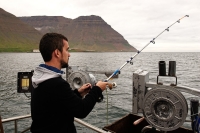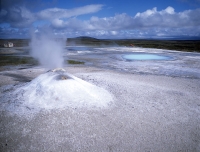
Iceland is said to be home to the best salmon fishing in the world, with over 100 runs, almost a quarter of which are first-class fishing holes. While sea fishing remains mostly the domain of commercial fishermen, tourists will find equally prosperous waters inland. The island is pocketed with lakes which make for great trout fishing and more well-rounded family vacations. Some of the best and most scenic lakes are in the highlands. However, aficionados will want to head to the rivers, fly rod in tow.Almost all fishing rivers can be driven to but it's best to arrange things through a tour operator, or travel with a guide who can also arrange fishing permits, a suitable vehicle and nearby lodging. The best salmon rivers all have impossible to pronounce names, such as Breiddalsa and Hrutafjardara making it tough to ask for directions.All of Iceland's rivers are very well regulated so limited rods are allowed on the same river at any one time. It is wise to arrange with a guide well in advance of the visit to assure a spot. Salmon season is June to September and trout season is June to October. Ice fishing in the winter is also an option to get the ones that got away in summer; leave the waders and bring a jacket.

Iceland offers a wealth of exciting outdoor sports opportunities to visitors - fishing, angling, hiking, camping, kayaking, skiing, mountain biking, golfing and scuba diving, to name but a few - but the great lure for real outdoor enthusiasts must be glacier trekking. There are many excellent, reputable tour companies offering visitors to Iceland the chance to unleash their inner Arctic explorer and experience Iceland's astounding natural bounty hands-on. Your adventure could consist of about seven hours of walking across the snow-blown, translucent landscape by day, before being fed and entertained while camping out on the freezing icefields at night. There are day-long tours available for less extreme personalities or less experienced trekkers, and some tours which combine glacier trekking with plenty of time spent camping next to hot springs and doing other, more relaxing things. Snæfellsjökull glacier is probably the pick of the explorable terrains but Iceland boasts many potential areas for this sort of activity.Travellers would be wrong to assume that glacier trekking is only possible in the summer months as many tour operators actually offer glacier tours and treks year-round. The frosty winter months, from November to February, have a beauty of their own, but inexperienced hikers may well be put off by the limited daylight which makes multi-day treks less popular for obvious reasons. Glacier trekking is a potentially dangerous activity and all hikers and climbers should ensure they are using a reputable tour company and good, safe gear - a capable guide can make all the difference so research your options ahead of time.

Travel Guide powered by Word Travels, copyright © 2023 Globe Media Ltd. By its very nature information in this travel guide is subject to change at short notice and travellers are urged to verify information on which they're relying with the relevant authorities. Neither Globe Media Ltd nor Travel Vogue can accept any responsibility for any loss or inconvenience to any person as a result of information contained above.